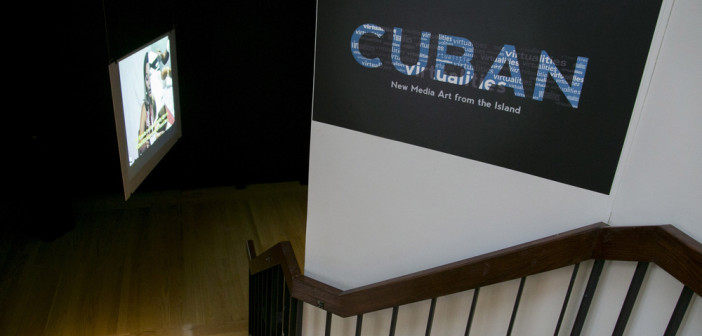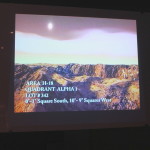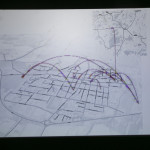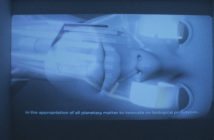The second group show of contemporary Cuban art to take place in Boston this fall, Cuban Virtualities: New Media Art from the Island (at Tufts University Gallery September 5 through December 8) was also the first exhibition of Cuban new media artists to be held outside the country. Co-organized in Boston and Havana by Liz Munsell and Rewell Altunaga, Cuban Virtualities presented artists all born in the 1970s and 1980s. Though their work is thematically rooted in the Cuban experience, conceptually these artists are preoccupied with resistance at home and abroad.
There is no anchor to Cuban Virtualities. The viewer descends a staircase into a dim, honey-combed gallery with work organized almost as if each were a piece of a jigsaw puzzle. This gives the space a shadowy, centerless feel, which largely parallels the experience of life on the Internet; one is never sure where borders begin and end, or who, exactly, one is with. Ernesto Leal’s New Resting Fatherland (2006) and Opposition Party (2009) open the show by investigating the very themes of virtual occupation and ownership. In New Resting Fatherland, a camera roves over Mars, as if to show a potential developer of the terrain. Opposition Party depicts Mars’s landowners in a revolt, showing titles and deeds to property on Mars in a split screen with a woman reading the owners’ complaints. Together, these works question the arbitrary nature of landownership by highlighting the absurdity of individual ownership in outer space. The value of land and money is confronted here, as viewers are reminded that Cubans were legally prohibited from owning their own homes until 2010, and that today, Cubans don’t have easy access to the Internet or many other technological resources. For Cubans denied a center at the global and local level, ownership is political, and technological fluency is resistance.
"Despite obvious challenges, or perhaps in part because of them, a generation of Cuban artists largely born during the 1970s and 80s is creating work that repurposes, reinterprets, hacks, cracks and deconstructs technologies developed in or by the U.S.," write Munsell and Altunaga in their curatorial statement. In Rahab (2013), Naivy Pérez questions the purposes of such technologies. In the gallery space, a monitor reflects Pérez’s precise location on a Google map; while the show was open, Pérez wore a red scarf and a GPS tracking device as she traversed Boston and the surrounding areas. The red scarf referencing Rahab from the Book of Joshua, Pérez uses it to distinguish herself as an immigrant to the city while the GPS and the mapped location manifest the anxiety of both watching and being watched in our ever-increasing culture of surveillance. By placing her location, via the virtual map, on the gallery wall, Pérez inverts the system of observation, creating a way in which a chosen audience (gallery visitors) sees her presence. Pérez, the observed, constructs the method through which the observation occurs.
Reclamation of power is also a theme in works nearby, such as Rodolfo Peraza’s Fangito (2013) and Glenda Léon’s Inversion (2011). In both works, the artist is something of a ghost; in Fangito, we see the artist’s studio as dark and empty, a place uninhabited because he’s prohibited from returning to the space. Peraza’s studio appears as a mirage projected onto the walls of the gallery, a private space made public. In Inversion, the artist’s hands use a razorblade to scrape a one hundred dollar bill into dust and a pale green curl of paper. The dust is cut into lines as if it were cocaine and then snorted with a rolled-up tea leaf, but the artist’s face is never revealed. Both works present a vision of life as it is parceled by politics, economies and labor. Peraza is forced to abandon his place of work, his studio, and therefore his absence becomes the work. Léon upturns the system through which plant is turned to money, via product or pulp, all the while obscuring the consumer. Nevertheless, both works resist political domination and economic subjugation via their insistence on upending the power systems that be.
Work by Alexander Arrechea, Celia y Yunior and Mauricio Abad explores how local and global socioeconomic conditions create home and community. In Arrechea’s The Room of All (2009), home is simply an abstraction, expressed through an intertwined system of money and innovation. In Faceloop (2013), Celia y Yunior present an image of a community digitally and physically, exploiting old and new technologies. Abad’s Street (2012) insists that the viewer engages with technology in order to experience it, a reminder of the personal connections we loose when we refuse to participate in social media. But moreover, this work suggests how certain communities become invisible when examined through Globalism’s lens. How can we see others if we are only looking through certain channels?
Perhaps the most emotional work in Cuban Virtualites is one that most plainly exploits our view into a virtual world. Susana Pilar Delahante Matienzo’s Mirror of Patience (2013) is a projected moving image of the artist interacting with the audience. For the first month of the show, while on a residency in Germany, Matienzo was virtually present in the gallery space to talk or play with viewers; after her residency, Matienzo returned to Cuba, where she only had access to the island’s Intranet. For the remainder of the show, Matienzo was a visage of her virtual self, as later viewers could only see a recording of her engagement with previous viewers. It’s hard to not see the recorded version as sad, as Matienzo was clearly excited to virtually interact with the people who came to see her work. Her absence heightened by her virtual presence, in Mirror of Patience, Matienzo magnifies distance by her attempt to contract it.
Mirror of Patience offers a poignant analog to Maria Magdalena Campos-Pons’s Spoken Softly (1998), installed on the floor immediately above Cuban Virtualities. Presented as part of her solo show, My Mother Told Me, Campos-Pons’s Spoken Softly blends photographs, textiles, glass and wood in order to evoke an image of her past as imagined through the materials of public and private histories. Dispensing (but not altogether dispelling) the object, the artists in Cuban Virtualities are likewise invested in exploring how the island’s global history is lived out in the local present. However, the show is more than a look at new media art produced Cuba’s current conditions. Ultimately, Cuban Virtualities is a neat reflection of the resistance to the essentialisms of Globalism and New Localism.
- Installation view, Cuban Virtualities.
- From Ernesto Leal’s New Resting Fatherland (2009).
- From Glenda Léon’s Inversion (2011).
- From Celia y Yunior’s Faceloop (2013).
- From Arrechea’s The Room of All (2009).
- From Susana Pilar Delahante Matienzo’s Mirror of Patience (2013).













